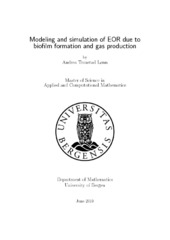| dc.description.abstract | Microbial enhanced oil recovery (MEOR) is a collective term for more environmen- tally friendly enhanced oil recovery (EOR) techniques. EOR methods are techniques used after primary and secondary stage of oil recovery aiming to increase the amount of oil recovered from the reservoir. In this thesis we look at MEOR methods, more specifically bioclogging using biofilm. We have simulated a two-phase system containing of oil, water, nutrients, biofilm and gas in MATLAB using the MRST package from SINTEF. The gas in our system is produced by the biofilm, which is assumed to dissolve in the oil phase; therefore we modeled it with a transport equation. We assumed that the nutrients are dissolved only in the water phase and therefore we simulate the nutrients in a similar way as the gas. The two phases, water and oil, are simulated by mass conservation equations and the biofilm is modeled by the equation for reversible deposited bacteria proposed by Kim (2006). The implementation of the model has been tested using an analytical solution and a benchmark example. In addition to making our model, we have studied how the gas produced from the biofilm can affect the oil viscosity and, as a result, affect the amount of oil being produced. We have also studied how the positioning of the biofilm can affect the oil production. Last but not least, we have looked at how the combination of strategic positioning of the biofilm and viscosity reduction due to gas production will affect the oil recovery. Our results show that the amount of oil recovered by using biofilm to preform bio- clogging will increase if we model the oil viscosity as a function of the gas produced. The oil recovery will also increase if the biofilm is located at the beginning of the core instead of evenly distributed in every cell. The best result is obtained when we combine these two scenarios, in other words, when the biofilm is located at the beginning of the domain and the oil viscosity is modeled as a function of the gas produced in the system. | en_US |
